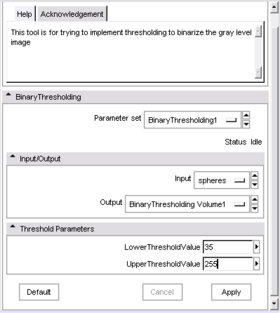Difference between revisions of "Slicer3:Module:BinaryThresholding-Documentation-3.2"
m (1 revision) |
|
(No difference)
| |
Latest revision as of 02:24, 10 January 2009
Home < Slicer3:Module:BinaryThresholding-Documentation-3.2Return to Slicer Documentation
Binary Thresholding
GENERAL INFORMATION
Module Type&Category
Type of this module is CLI and is under the category named Segmentation in Slicer 3.
Authors, Collaborators&Contact
- Author: Bike Kilic, MSc student in Northeastern University
- Contact: kilicbike@gmail.com
Module Description
The purpose of this module is implementing simple binary thresholding in order to get a binary image at the end. In this project, the input is two spheres which are connected to each other and after this process, the pixel value of the inside of the connected spheres becomes 255, whereas the outside value is 0.
In order to add the input, from the File tab of Slicer 3, the inputted volume is added to the data module. In this project the input is "spheres.nrrd" as seen in the part of Screen shots in Binary Morphological Operations. The output of binary thresholding is then used for erosion.
USAGE
Quick Tour of Features and Use
DEVELOPMENT
Dependencies
In order to implement binary thresholding, itkBinaryThresholdImageFilter class has been used.[1]
This module is used to binarize an input image by thresholding.
The ITK filter produces an output image whose pixels are either one of two values ( OutsideValue or InsideValue ), depending on whether of not the corresponding input image pixel lie between the two thresholds ( LowerThreshold and UpperThreshold ). Values equal to either threshold is considered to be between the thresholds.
As seen in the GUI panel uploaded below, the LowerThreshold is 35 and the UpperThreshold value is 255. The InsideValue is 255, whereas OutsideValue is 0.
The Problems
No problem has been occurred in this module. However, the performance of this module depends on the data. If data does not have good contrast, the thresholding does not work as expected. Therefore, there should be another algorithm which helps the user to look at the grey-level values of the data in order to pick the correct threshold intervals. On the other hand, if the data is noisy, has low contrast, blurred, in this module any smoothing or reconstruction method can be included before binary thresholding in order to enhance the image.
MORE INFORMATION
Future work
As a future work, another ITK class can be added into this module which can help reducing the unexpected noises in the input image before performing binary thresholding.
References
- Ibanez L.,ITK Architecture, ITK Basic Filters, 2006.
- Ibanez L.,ITK Arcitecture, ITK Segmentation Methods, 2000.
- Ibanez L., Schroeder W.,Ng L. & Cates J., The ITK Software Guide Second Edition Updated for ITK Version 2.4, 2005.
